Python在ABAQUS二次开发中的应用实例2..
- 格式:ppt
- 大小:2.07 MB
- 文档页数:24
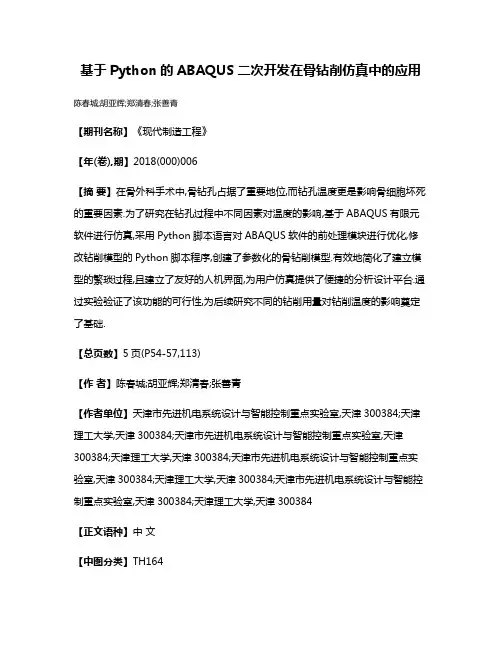
基于Python的ABAQUS二次开发在骨钻削仿真中的应用陈春城;胡亚辉;郑清春;张善青【期刊名称】《现代制造工程》【年(卷),期】2018(000)006【摘要】在骨外科手术中,骨钻孔占据了重要地位,而钻孔温度更是影响骨细胞坏死的重要因素.为了研究在钻孔过程中不同因素对温度的影响,基于ABAQUS有限元软件进行仿真,采用Python脚本语言对ABAQUS软件的前处理模块进行优化,修改钻削模型的Python脚本程序,创建了参数化的骨钻削模型.有效地简化了建立模型的繁琐过程,且建立了友好的人机界面,为用户仿真提供了便捷的分析设计平台.通过实验验证了该功能的可行性,为后续研究不同的钻削用量对钻削温度的影响奠定了基础.【总页数】5页(P54-57,113)【作者】陈春城;胡亚辉;郑清春;张善青【作者单位】天津市先进机电系统设计与智能控制重点实验室,天津300384;天津理工大学,天津300384;天津市先进机电系统设计与智能控制重点实验室,天津300384;天津理工大学,天津300384;天津市先进机电系统设计与智能控制重点实验室,天津300384;天津理工大学,天津300384;天津市先进机电系统设计与智能控制重点实验室,天津300384;天津理工大学,天津300384【正文语种】中文【中图分类】TH164【相关文献】1.基于Python的Abaqus二次开发在空间可展单簧片结构仿真分析中的应用 [J], 叶红玲;胡腾;赵春华;肖燕妮2.基于Python的Abaqus二次开发在层压板修理模拟中的应用 [J], 郭霞;关志东;刘遂;陈萍;刘佳;王欣晶;邱太文3.基于Python/ABAQUS二次开发在创建变速器内部传动系有限元模型的应用 [J], 王金明;邓小梅4.基于Python的ABAQUS二次开发在飞机蒙皮锤铆中的应用 [J], 陈彦海;秦运海;姜春英;康玉祥;叶长龙5.基于Python的ABAQUS二次开发在复合材料层合板冲击建模中的应用 [J], 陈芳育;李进;邱玮桢;吕泉江因版权原因,仅展示原文概要,查看原文内容请购买。
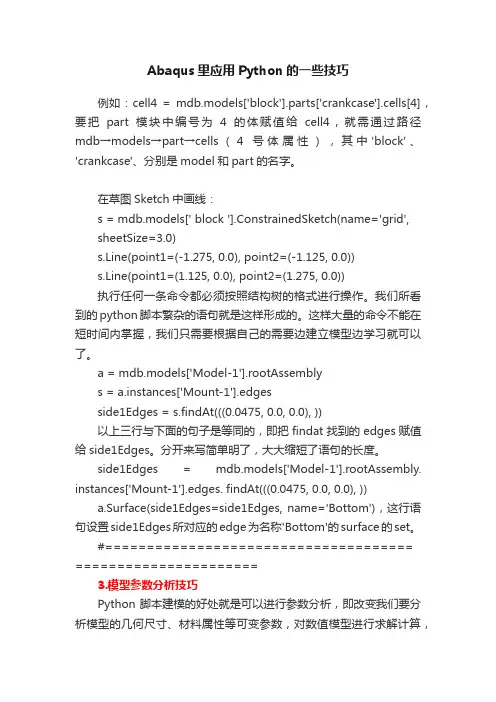
Abaqus里应用Python的一些技巧例如:cell4 = mdb.models['block'].parts['crankcase'].cells[4],要把part模块中编号为4的体赋值给cell4,就需通过路径mdb→models→part→cells(4号体属性),其中'block'、'crankcase'、分别是model和part的名字。
在草图Sketch中画线:s = mdb.models[' block '].ConstrainedSketch(name='grid',sheetSize=3.0)s.Line(point1=(-1.275, 0.0), point2=(-1.125, 0.0))s.Line(point1=(1.125, 0.0), point2=(1.275, 0.0))执行任何一条命令都必须按照结构树的格式进行操作。
我们所看到的python脚本繁杂的语句就是这样形成的。
这样大量的命令不能在短时间内掌握,我们只需要根据自己的需要边建立模型边学习就可以了。
a = mdb.models['Model-1'].rootAssemblys = a.instances['Mount-1'].edgesside1Edges = s.findAt(((0.0475, 0.0, 0.0), ))以上三行与下面的句子是等同的,即把findat找到的edges赋值给side1Edges。
分开来写简单明了,大大缩短了语句的长度。
side1Edges = mdb.models['Model-1'].rootAssembly. instances['Mount-1'].edges. findAt(((0.0475, 0.0, 0.0), ))a.Surface(side1Edges=side1Edges, name='Bottom'),这行语句设置side1Edges所对应的edge为名称'Bottom'的surface的set。
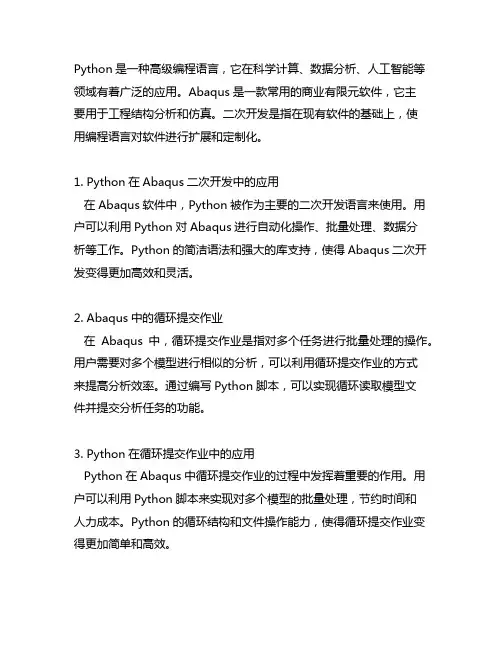
Python是一种高级编程语言,它在科学计算、数据分析、人工智能等领域有着广泛的应用。
Abaqus是一款常用的商业有限元软件,它主要用于工程结构分析和仿真。
二次开发是指在现有软件的基础上,使用编程语言对软件进行扩展和定制化。
1. Python在Abaqus二次开发中的应用在Abaqus软件中,Python被作为主要的二次开发语言来使用。
用户可以利用Python对Abaqus进行自动化操作、批量处理、数据分析等工作。
Python的简洁语法和强大的库支持,使得Abaqus二次开发变得更加高效和灵活。
2. Abaqus中的循环提交作业在Abaqus中,循环提交作业是指对多个任务进行批量处理的操作。
用户需要对多个模型进行相似的分析,可以利用循环提交作业的方式来提高分析效率。
通过编写Python脚本,可以实现循环读取模型文件并提交分析任务的功能。
3. Python在循环提交作业中的应用Python在Abaqus中循环提交作业的过程中发挥着重要的作用。
用户可以利用Python脚本来实现对多个模型的批量处理,节约时间和人力成本。
Python的循环结构和文件操作能力,使得循环提交作业变得更加简单和高效。
4. 二次开发与循环提交作业的结合通过Python的二次开发功能,用户可以定制化地实现循环提交作业的功能。
用户可以编写Python脚本来实现针对特定工程需求的循环提交作业流程,提高软件的灵活性和适用性。
二次开发也可以使得循环提交作业的过程更加智能化和自动化。
5. 实例分析以某工程仿真为例,用户需要对多个零件进行疲劳分析。
通过Python的二次开发,用户可以编写循环提交作业的脚本,实现自动读取不同零件模型并提交分析任务的功能。
这样一来,用户无需手动逐个提交任务,极大地提高了分析工作的效率。
Python在Abaqus的二次开发中能够很好地支持循环提交作业的功能。
通过二次开发,用户可以定制化地实现循环提交作业的流程,提高软件的适用性和工作效率。
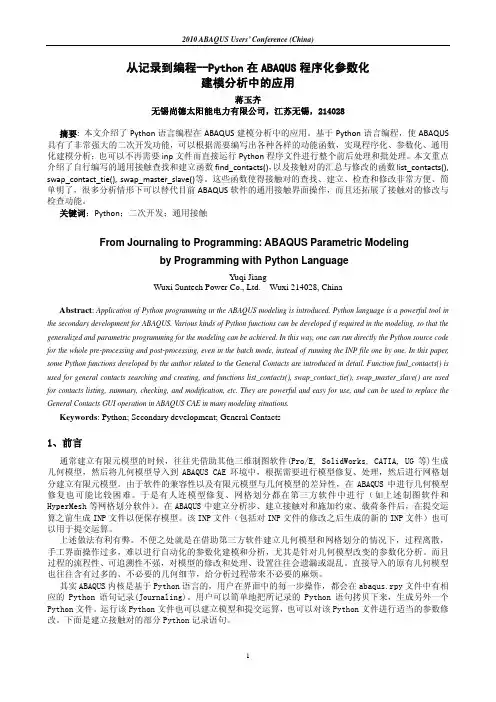
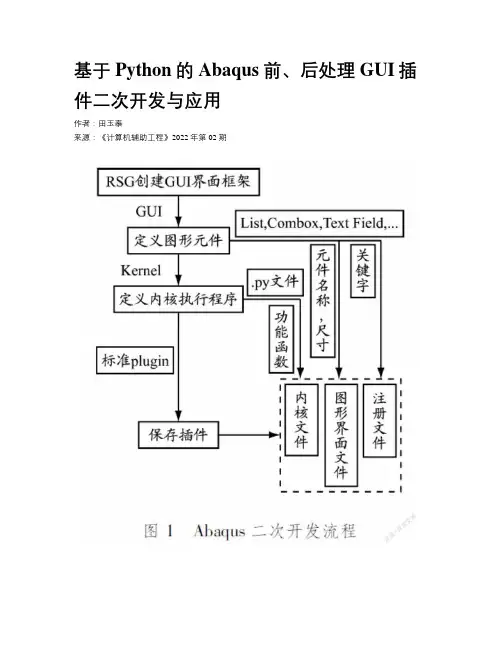
基于Python的Abaqus前、后处理GUI插件二次开发与应用作者:***来源:《计算机辅助工程》2022年第02期摘要:为提高Abaqus建模效率并进行可视化数据分析,利用Python语言对Abaqus前-后处理进行二次开发。
分析某柴油机机油-水冷却器模块组件,结果表明:前处理模块开发螺栓GUI插件,能够批量创建相同规格的螺栓载荷,提高前期建模效率,缩短分析周期;后处理模块开发Campbell制图插件,能根据工程实际需要将模态结果数据绘制成Campbell图,并将计算结果可视化输出。
关键词: Abaqus; Python; 二次开发; 前处理; 后处理; GUI界面中图分类号: TP391.99; TB115.1文献标志码: BGUI plugin redevelopment and application of Abaquspre-and post-processing based on PythonTIAN Yutai(Shanghai New Power Automotive Technology Co., Ltd., Shanghai 200438, China)Abstract: To improve the efficiency of Abaqus modeling and achieve visual data analysis,redevelopment of Abaqus pre-and post-processing is carried out with Python language. A diesel engine oil-water cooler module is analyzed. The results show that: a bolt GUI plug-in is developed for the pre-processing module, which can create bolt loads of the same specification in bulk,improving pre-modeling efficiency and shortening the analysis cycle; the Campbell mapping plug-in is investigated for the post-processing module, which can draw the modal result data into Campbell diagrams according to the actual needs of engineering and visualize the calculation results for output.Key words: Abaqus;Python; redevelopment; pre-processing;post-processing; GUI interface0引言作为国际通用计算分析软件,Abaqus具有丰富的单元类型与材料非线性模型,在各领域发挥至关重要的作用。
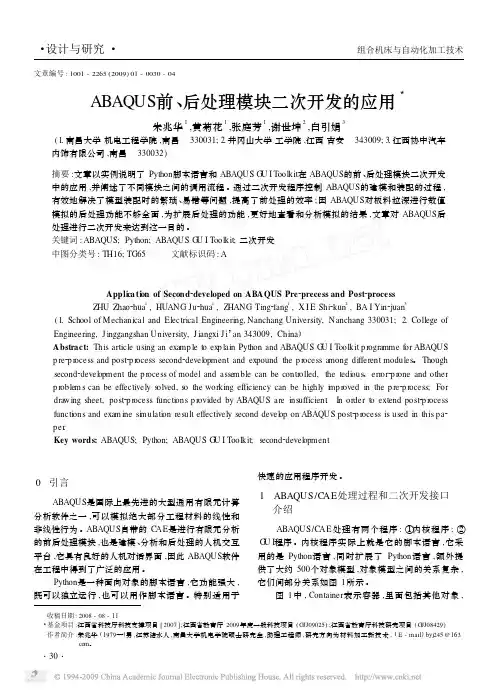
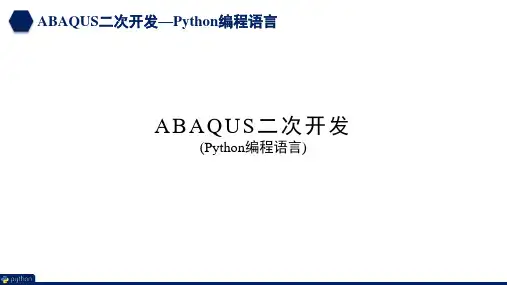
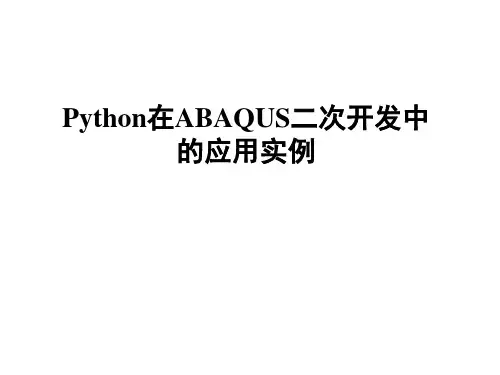
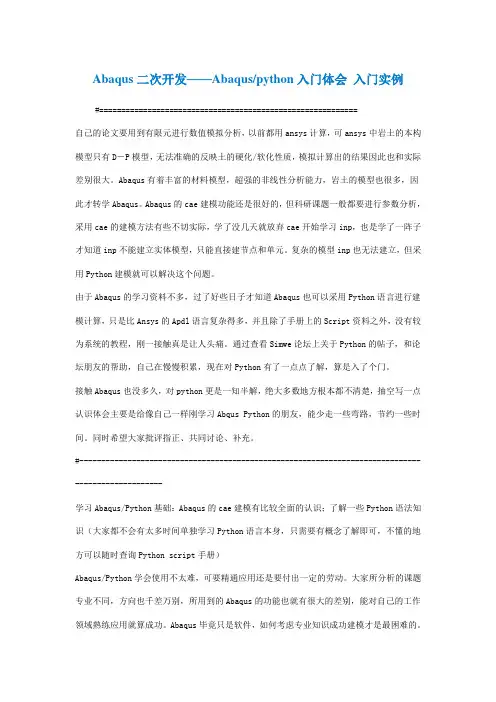
Abaqus二次开发——Abaqus/python入门体会入门实例#===========================================================自己的论文要用到有限元进行数值模拟分析,以前都用ansys计算,可ansys中岩土的本构模型只有D-P模型,无法准确的反映土的硬化/软化性质,模拟计算出的结果因此也和实际差别很大。
Abaqus有着丰富的材料模型,超强的非线性分析能力,岩土的模型也很多,因此才转学Abaqus。
Abaqus的cae建模功能还是很好的,但科研课题一般都要进行参数分析,采用cae的建模方法有些不切实际,学了没几天就放弃cae开始学习inp,也是学了一阵子才知道inp不能建立实体模型,只能直接建节点和单元。
复杂的模型inp也无法建立,但采用Python建模就可以解决这个问题。
由于Abaqus的学习资料不多,过了好些日子才知道Abaqus也可以采用Python语言进行建模计算,只是比Ansys的Apdl语言复杂得多,并且除了手册上的Script资料之外,没有较为系统的教程,刚一接触真是让人头痛。
通过查看Simwe论坛上关于Python的帖子,和论坛朋友的帮助,自己在慢慢积累,现在对Python有了一点点了解,算是入了个门。
接触Abaqus也没多久,对python更是一知半解,绝大多数地方根本都不清楚,抽空写一点认识体会主要是给像自己一样刚学习Abqus Python的朋友,能少走一些弯路,节约一些时间。
同时希望大家批评指正、共同讨论、补充。
#--------------------------------------------------------------------------------------------------学习Abaqus/Python基础:Abaqus的cae建模有比较全面的认识;了解一些Python语法知识(大家都不会有太多时间单独学习Python语言本身,只需要有概念了解即可,不懂的地方可以随时查询Python script手册)Abaqus/Python学会使用不太难,可要精通应用还是要付出一定的劳动。
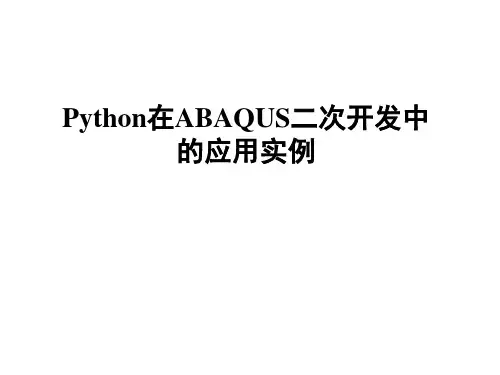
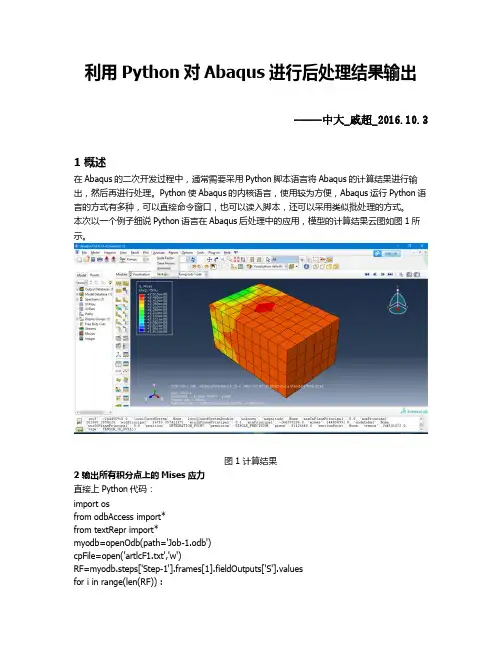
利用Python对Abaqus进行后处理结果输出-----中大_戚超_2016.10.31 概述在Abaqus的二次开发过程中,通常需要采用Python脚本语言将Abaqus的计算结果进行输出,然后再进行处理。
Python使Abaqus的内核语言,使用较为方便,Abaqus运行Python语言的方式有多种,可以直接命令窗口,也可以读入脚本,还可以采用类似批处理的方式。
本次以一个例子细说Python语言在Abaqus后处理中的应用,模型的计算结果云图如图1所示。
图1 计算结果2 输出所有积分点上的Mises应力直接上Python代码:import osfrom odbAccess import*from textRepr import*myodb=openOdb(path='Job-1.odb')cpFile=open('artlcF1.txt','w')RF=myodb.steps['Step-1'].frames[1].fieldOutputs['S'].valuesfor i in range(len(RF)) :cpFile.write('%.3F\n' %(RF[i].mises))else:cpFile.close()#引入模块,因为需要打开结果文件#打开结果文件,并复制给变量myodb#打开一个txt文件#将输出场赋值给RF#循环语句,向txt文件逐行写入mises应力Abaqus的结构层次分的很细,比如结果文件下分如下:使用过Abaqus的都知道step表示载荷步,frame表示载荷子步,因而在读取Mises应力时需要详细地指定输出哪一步的应力,而应力结果是输出场数据(fieldOutput)的中一种,需要指定是何种应力,程序才知道怎么读取并写入。
由于Abaqus里面涉及的变量特别多,通常很难记清楚那一项下面都有哪些量可以调用,此时比较好的方式是采用print 函数查看,例如查看myodb.steps['Step-1'].frames[1].fieldOutputs 下面有哪些变量可以调用,在窗口输入:print myodb.steps['Step-1'].frames[1].fieldOutputs显示:{'AC YIELD': 'FieldOutput object', 'CF': 'FieldOutput object', 'E': 'FieldOutput object', 'PE': 'Fiel dOutput object', 'PEEQ': 'FieldOutput object', 'PEMAG': 'FieldOutput object', 'RF': 'FieldOutput object', 'S': 'FieldOutput object', 'U': 'FieldOutput object'}各种不同的结果,包括位移、应力和支反力等等,因此可以知道通过如下的方式读取应力:myodb.steps['Step-1'].frames[1].fieldOutputs ['S']此时读取的信息特别多,我们想要的是其中的数值信息,因此可以:myodb.steps['Step-1'].frames[1].fieldOutputs ['S'].values通过此句能够读取所有节点的应力数据,输出其中一个:print myodb.steps['Step-1'].frames[1].fieldOutputs ['S'].values[0]显示:({'baseElementType': 'C3D8R', 'conjugateData': None, 'conjugateDataDouble': 'unknown', 'da ta': array([-855397.25, 58.817497253418, 358.723419189453, -139.652938842773, -456.986175537109, 4.29301929473877], 'f'), 'dataDouble': 'unknown', 'elementLabel': 1, 'fac e': None, 'instance': 'OdbInstance object', 'integrationPoint': 1, 'inv3': -855606.3125, 'localCoordSystem': None, 'localCoordSystemDouble': 'unknown', 'magnitude': None, 'maxInPlanePrincipal': 0.0, 'maxPrincipal': 359.0310********, 'midPrincipal': 58.7767 486572266, 'minInPlanePrincipal': 0.0, 'minPrincipal': -855397.5, 'mises': 855606.375, 'nodeLabel': None, 'outOfPlanePrincipal': 0.0, 'position': INTE GRATION_POINT, 'precision': SINGLE_PRECISION, 'press': 284993.25, 'sectionPoint': None, 'tr esca': 855756.5, 'type': TENSOR_3D_FULL})输出的信息特别多,但是可以看到有mises这一项。
abaqus-python二次开发方法(超实用)基于的二次开发对于很多新手来说都是一个神秘的,感觉是高难度的问题,致使很多新手对二次开发的研究都处于初级了解阶段,或完全不感冒阶段。
其实二次开发很简单,某种意义上讲,常用的ABAQUS二次开发方式有两种,(1)直接修改inp文件,这种方式需要对inp文件中大量的节点和单元进行操作,一般不建议采用inp文件进行二次开发(除非有特殊的关键字或标识符,其实关键字也可以用python语言来进行二次开发,笔者亲证)。
采用inp文件进行二次开发数据量大,行数多,一旦发生问题难以检测错误原因(2)采用abaqus语言,自编脚本,简单容易,非常适合初学者。
这里主要介绍python入门python语言的开发远没有想象中的难,其实基于abaqus语言的二次开发更像是word或excel里的VBA,我们只要通过录制一段宏文件,就可以简单迅速的完成一个模型的建立,当我们人为的对这段宏文件进行修改,就可以完成对该模型的修改,非常适合有大量相同或类似模型的建立,防止用户一遍又一遍繁琐的建模操作。
简单的步骤如下:1.在建模前先打开file--Macro Manager,然后新建一个宏文件(在Home或Work都行,只要你最终能找到这个文件),此时会弹出Record Macro对话框,托至不碍事的地方2.进行正常的cae建模就行,至到建模完成3.点击Record Macro对话框的Stop Mecording,此时命令栏会显示“Macro "Macroname" has been added to "E:\Temp\Macroname.py"”,前期任务搞定4.此时用文本编辑器打开此py文件,py文件中有些文字是没有用的,把“def Macro1 ...import connectorBehavior”都可以删掉,每行字前的空格都要去掉(文本编辑器里一般有列模式,用列模式可以对整个文本的进行操作)5.复制你新生成的python文件,并对该文件中的参数进行修改,在提交给abaqus--cae就可以完成重复建模了,如此可以无限重复,其实python语言都是大白话,你能看懂的需要指出的是:1.可以结合其它编程语言如VB、VC 配合修改参数并生成py文件,使用更为灵活2.生成py文件可以直接在cae中选择file-run script,选择你生成的python文件3.可以用python文件直接生成cae模型文件,可在py文件最后添加"mdb.saveAs(pathName='" *** "')"4.可以通过cmd命令直接将py文件提交个abaqus内核,让abaqus进行运算,cmd命令为“Shell"C:\Windows\SysWOW64\cmd.exe /k abaqus cae noGUI=" **** ".py ", vbHide等待abaqus运算的py语言"myJob.submit(consistencyChecking=OFF, datacheckJob=True)"。
Python语言在ABAQUS中的应用采用python脚本语言二次开发ABAQUS,通过开发python脚本程序处理ABAQUS重复工作,提高了工作效率。
标签Python;ABAQUS;交换输入;函数引言ABAQUS是大型通用的有限元分析软件,可以模拟绝大部分工程材料的线性和非线性行为,获得了广大用户的认可,在建筑结构分析领域应用广泛。
Python是一种面向对象的脚本语言,,该语言已经诞生20余年,它的简洁性和易用性使程序的开发过程变得简单,特别适用于快速应用开发。
在此介绍一下编写脚本快速建模。
编写Python脚本快速建立模型是ABAQUS高级用户经常使用的功能之一。
例如,在Abaqus/CAE中建模时需要反复输入各种参数和设置多个对话框,编写脚本只需要几条语句就可以实现。
如果经常建立相同或类似模型,还可以编写独立的模块,还可以编写脚本创建材料库,运行Python脚本后Material Manager 将自动出现定义的材料。
在此介绍3种最常用的快速建立模型的方法,包括交互式输入、创建材料库。
1.交互式输入交互式输入直接指定模型参数,而无需在Abaqus/CAE下选择多个菜单、多个按钮,可以节省许多建模时间。
Abaqus脚本接口提供3种交互式输入函数,分别是:getInput()函数、getInputs()函数和getWarningReply ()函数,详细介绍参见Abaqus 6.10帮助手册《Abaqus Scripting User’s Manual》第6.7节“Prompting the user for input”和<《Abaqus Scripting Reference Manual》第49.5节“User input commands”。
GetInput()函数脚本getInput.py将调用getInput()函数自定义输入参数,开平方根运算后输出计算结果。
程序测试代码如下:from abaqus import *from math import sqrtinput=getInput(’please enter a number ‘,’9’)number=float(input)print sqrt(number)GetInputs()函数脚本getInputs.py将调用getInputs()函数自定义输入并输出数据信息,代码如下:from abaqus import *x=getInputs(((’please enter the first number ‘,’2’),(’please enter the second number’,’5’),(’please enter the third number’,’8’)))print xGetWarningReply ()函数脚本getWarningReply.py将调用get Warning Reply ()函数来创建警告对话框。
Python语言和ABAQUS后处理二次开发1易桂莲杜家政隋允康2(北京工业大学机械工程与应用电子技术学院,100124北京)摘要:采用Python脚本语言二次开发ABAQUS的后处理模块,讨论了ABAQUS的脚本接口和对象模型在二次开发中的作用和调用流程。
通过开发Python脚本程序提取ABAQUS进行数值模拟后的计算结果,有效地解决了提取大量结果进行重复操作的问题,提高了后处理的效率。
关键词:ABAQUS后处理二次开发;Python;动力响应分析;振动特性0 引言ABAQUS是国际上最先进的大型通用有限元计算分析软件之一,可以模拟绝大部分工程材料的线性和非线性行为。
ABAQUS自带的CAE是进行有限元分析的前后处理模块,也是建模、分析和后处理的人机交互平台,它具有良好的人机对话界面,因此ABAQUS软件在工程中得到了广泛的应用。
Python是一种面向对象的脚本语言,它功能强大,既可以独立运行,也可以用作脚本语言。
特别适用于快速的应用程序开发[1]。
通过开发Python脚本程序提取ABAQUS进行数值模拟后的计算结果,有效地解决了提取大量结果进行重复操作的问题1 二次开发接口介绍ABAQUS 脚本接口是一个基于对象的程序库,脚本接口中的每个对象都拥有相应的数据成员和函数。
对象的函数专门用于处理对象中的数据成员,被称为相应对象的方法,用于生成对象的方法被称为构造函数。
在对象创建后,可以使用该对象提供的方法来处理对象中的数据成员[2]。
ABAQUS提供了一套应用程序编程接口(API,Application Program Interface)来操作ABAQUS/CAE实现建模/后处理等功能。
接口编程采用Python的语法编写脚本,但扩展了Python脚本语言,额外提供了大约500个对象模型。
对象模型之间关系复杂,图1展示了这些对象模型之间的层次结构和相互关系。
其中,Container表示容器,里面包含有其他的对象;Singular object表示单个对象。
基于Python的Abaqus二次开发实例讲解(asian58 2013.6.26)基于Python的Abaqus的二次开发便捷之处在于:1、所有的代码均可以先在Abaqus\CAE中操作一遍后再通过rp文件读取,然后再在此基础上进行相应的修改;2、Python是一种解释性语言,读起来非常清晰,因此在修改程序的过程中,不存在程序难以理解的问题;3、Python是一种通用性的、功能非常强大的面向对象编程语言,有许多成熟的类似于Matlab函数的程序在网络上流传,为后期进一步的数据处理提供了方便。
为了更加方便地完成Abaqus的二次开发,需进行一些相关约定:1、所有参数化直接通过点的坐标值进行,直接对几何尺寸的参数化反而更加繁琐;2、程序参数化已不允许在模型中添加太多的Tie,因此不同零部件的绑定直接通过共节点来进行,这就要求建模方法与常规的建模方法有所区别。
思路如下:将一个整机拆成几个大的Part来建立,一个Part中包含许多零件,这样在划分网格式时就可以自动实现共节点的绑定。
不同的零件可通过建立不同的Set来进行区分,不同Part 的绑定可以通过Tie来实现。
将一个复杂的结构拆成几个恰当的Part来建立,一方面可以将复杂的模型简单化,使建立复杂模型成为可能;另一方面,不同的Part可单独调用,从而又可实现程序的模块化,增加程序的适应范围,延长程序的使用寿命,也方便后期程序的维护和修改。
3、通过py文件建立起的模型要进行参数优化,已不适合采用Isight中Abaqus模块,需要用到Isight的Simcode模块。
下面详细解释一个臂架的py文件。
#此程序用来绘制臂架前段#导入相关模块# -*- coding: mbcs -*-from abaqus import *from abaqusConstants import *#定义整个臂架的长、宽、高L0=14300W0=1650H0=800#创建零件P01_12 L1=H0+200 W1=200 T1=12s = mdb.models['Model-1'].ConstrainedSketch(name='__profile__', sheetSize=2000.0)g, v, d, c = s.geometry, s.vertices, s.dimensions, s.constraints s.setPrimaryObject(option=STANDALONE)s.rectangle(point1=(W0/2, L1/2), point2=(W0/2+W1, -L1/2))s.rectangle(point1=(-W0/2, L1/2), point2=(-W0/2-W1, -L1/2))p = mdb.models['Model-1'].Part(name='Part-1', dimensionality=THREE_D, type=DEFORMABLE_BODY)p = mdb.models['Model-1'].parts['Part-1'] p.BaseShell(sketch=s)session.viewports['Viewport: 1'].setValues(displayedObject=p) del mdb.models['Model-1'].sketches['__profile__']#定义零件的厚度p = mdb.models['Model-1'].parts['Part-1'] f = p.faces pickedFaces01 = f.findAt (((W0/2, L1/2, 0),),((-W0/2, L1/2, 0),), ) p.assignThickness(faces=pickedFaces01, thickness=T1) p.Set(faces=pickedFaces01, name='P01_12')#创建辅助平面和辅助坐标系p = mdb.models['Model-1'].parts['Part-1']p.DatumCsysByThreePoints(name='Datum csys-1', coordSysType=CARTESIAN, origin=( 0.0, 0.0, 0.0), line1=(1.0, 0.0, 0.0), line2=(0.0, 1.0, 0.0))p = mdb.models['Model-1'].parts['Part-1']p.DatumPlaneByPrincipalPlane(principalPlane=XYPLANE, offset=L0)#创建零件P02_12 L2=L1 W2=W1 T2=12p = mdb.models['Model-1'].parts['Part-1'] d = p.datums#将草图原点参数化t = p.MakeSketchTransform(sketchPlane=d[5], sketchUpEdge=d[4].axis2, sketchPlaneSide=SIDE1, sketchOrientation=RIGHT, origin=(0.0, 0.0, L0)) s = mdb.models['Model-1'].ConstrainedSketch(name='__profile__', sheetSize=29006.85, gridSpacing=725.17, transform=t) g, v, d1, c = s.geometry, s.vertices, s.dimensions, s.constraints s.setPrimaryObject(option=SUPERIMPOSE)p = mdb.models['Model-1'].parts['Part-1']s.rectangle(point1=(W0/2, L2/2), point2=(W0/2+W2, -L2/2))s.rectangle(point1=(-W0/2, L2/2), point2=(-W0/2-W2, -L2/2))p = mdb.models['Model-1'].parts['Part-1']d2 = p.datumsp.Shell(sketchPlane=d2[5], sketchUpEdge=d2[4].axis2, sketchPlaneSide=SIDE1, sketchOrientation=RIGHT, sketch=s)s.unsetPrimaryObject()del mdb.models['Model-1'].sketches['__profile__']#定义零件的厚度p = mdb.models['Model-1'].parts['Part-1'] Array f = p.facespickedFaces02 = f.findAt(((W0/2, L1/2, L0),),((-W0/2, L1/2, L0),), )p.assignThickness(faces=pickedFaces02, thickness=T2)p.Set(faces=pickedFaces02, name='P02_12')#创建零件P03_12和零件P04_08T3=12T4=8p = mdb.models['Model-1'].parts['Part-1']d = p.datumst = p.MakeSketchTransform(sketchPlane=d[5], sketchUpEdge=d[4].axis2, sketchPlaneSide=SIDE1, sketchOrientation=RIGHT, origin=(0.0, 0.0, L0)) s = mdb.models['Model-1'].ConstrainedSketch(name='__profile__', sheetSize=29006.85, gridSpacing=725.17, transform=t)g, v, d1, c = s.geometry, s.vertices, s.dimensions, s.constraintss.setPrimaryObject(option=SUPERIMPOSE)#创建草图p = mdb.models['Model-1'].parts['Part-1']s.Line(point1=(-W0/2-W1, H0/2), point2=(-W0/2, H0/2))s.Line(point1=(W0/2, H0/2), point2=(W0/2+W1, H0/2))s.Line(point1=(-W0/2-W1, -H0/2), point2=(-W0/2, -H0/2))s.Line(point1=(W0/2, -H0/2), point2=(W0/2+W1, -H0/2))p = mdb.models['Model-1'].parts['Part-1']d2 = p.datumsp.ShellExtrude(sketchPlane=d2[5], sketchUpEdge=d2[4].axis2,sketchPlaneSide=SIDE1, sketchOrientation=RIGHT, sketch=s, depth=L0, flipExtrudeDirection=ON)s.unsetPrimaryObject()del mdb.models['Model-1'].sketches['__profile__']#定义零件P03_12的厚度p = mdb.models['Model-1'].parts['Part-1']f = p.facespickedFaces03 = f.findAt(((-W0/2, H0/2, L0/2),),((W0/2, H0/2, L0/2),),)p.assignThickness(faces=pickedFaces03, thickness=T3)p.Set(faces=pickedFaces03, name='P03_12')#定义零件P04_12的厚度p = mdb.models['Model-1'].parts['Part-1']f = p.facespickedFaces04 = f.findAt(((-W0/2, -H0/2, L0/2),),((W0/2, -H0/2, L0/2),),)p.assignThickness(faces=pickedFaces04, thickness=T4)p.Set(faces=pickedFaces04, name='P04_12')#创建零件P05_08T5=8p = mdb.models['Model-1'].parts['Part-1']d = p.datumst = p.MakeSketchTransform(sketchPlane=d[5], sketchUpEdge=d[4].axis2, sketchPlaneSide=SIDE1, sketchOrientation=RIGHT, origin=(0.0, 0.0, L0))s = mdb.models['Model-1'].ConstrainedSketch(name='__profile__',sheetSize=29006.85, gridSpacing=725.17, transform=t)g, v, d1, c = s.geometry, s.vertices, s.dimensions, s.constraintss.setPrimaryObject(option=SUPERIMPOSE)p = mdb.models['Model-1'].parts['Part-1']s.Line(point1=(-W0/2-W1/2, H0/2), point2=(-W0/2-W1/2, -H0/2))s.Line(point1=(W0/2+W1/2, H0/2), point2=(W0/2+W1/2, -H0/2))p = mdb.models['Model-1'].parts['Part-1']d2 = p.datumsp.ShellExtrude(sketchPlane=d2[5], sketchUpEdge=d2[4].axis2,sketchPlaneSide=SIDE1, sketchOrientation=RIGHT, sketch=s, depth=L0,flipExtrudeDirection=ON)s.unsetPrimaryObject()del mdb.models['Model-1'].sketches['__profile__']#定义零件P05_8的厚度p = mdb.models['Model-1'].parts['Part-1']f = p.facespickedFaces05 = f.findAt(((-W0/2-W1/2, 0, L0/2),),((W0/2+W1/2, 0, L0/2),),)p.assignThickness(faces=pickedFaces05, thickness=T5)p.Set(faces=pickedFaces05, name='P05_08')#创建零件P06_08L6=W0+W1n=L0//2520+1T6=8p = mdb.models['Model-1'].parts['Part-1']f, d = p.faces, p.datumst = p.MakeSketchTransform(sketchPlane=f[0], sketchUpEdge=d[4].axis2, sketchPlaneSide=SIDE1, sketchOrientation=RIGHT, origin=(W0/2+W1/2, -H0/2,0))s = mdb.models['Model-1'].ConstrainedSketch(name='__profile__',sheetSize=28684, gridSpacing=717, transform=t)g, v, d1, c = s.geometry, s.vertices, s.dimensions, s.constraintss.setPrimaryObject(option=SUPERIMPOSE)p = mdb.models['Model-1'].parts['Part-1']#循环命令绘制平行隔板for i in range(0,n): Array s.Line(point1=(-500-(i*2520), H0), point2=(-500-(i*2520), 0.0))p = mdb.models['Model-1'].parts['Part-1']f1, d2 = p.faces, p.datumsp.ShellExtrude(sketchPlane=f1[0], sketchUpEdge=d2[4].axis2,sketchPlaneSide=SIDE1, sketchOrientation=RIGHT, sketch=s, depth=L6,flipExtrudeDirection=ON)s.unsetPrimaryObject()del mdb.models['Model-1'].sketches['__profile__']#定义零件P06_08的厚度p = mdb.models['Model-1'].parts['Part-1']f = p.facesfor i in range(0,n): Array pickedFaces = f.findAt(((0, H0/4, 500+i*2520),))p.assignThickness(faces=pickedFaces, thickness=T6)p.Set(faces=pickedFaces, name='P06_08_'+str(1+i))#创建零件P07_12,P08_12W7=200L7=W0+W1T7=12T8=12p = mdb.models['Model-1'].parts['Part-1']f, e = p.faces, p.edgest = p.MakeSketchTransform(sketchPlane=f.findAt(coordinates=(W0/2+W1/2, 0.0, 100.0)),sketchUpEdge=e.findAt(coordinates=(W0/2+W1/2, 0.0, 0.0)),sketchOrientation=RIGHT,sketchPlaneSide=SIDE1,origin=(W0/2+W1/2, -H0/2, 0.0))s = mdb.models['Model-1'].ConstrainedSketch(name='__profile__',sheetSize=53678, gridSpacing=1341, transform=t)g, v, d, c = s.geometry, s.vertices, s.dimensions, s.constraintss.setPrimaryObject(option=SUPERIMPOSE)p = mdb.models['Model-1'].parts['Part-1']#循环命令绘制平行隔板for i in range(0,n):s.Line(point1=(400+i*2520, -H0), point2=(600+i*2520, -H0))s.Line(point1=(400+i*2520, 0), point2=(600+i*2520, 0))p = mdb.models['Model-1'].parts['Part-1']f1, e1 = p.faces, p.edgesp.ShellExtrude(sketchPlane=f.findAt(coordinates=(W0/2+W1/2, 0.0, 100.0)),sketchUpEdge=e.findAt(coordinates=(W0/2+W1/2, 0.0, 0.0)),sketchPlaneSide=SIDE1,sketchOrientation=RIGHT, sketch=s, depth=W0+W1, flipExtrudeDirection=ON, keepInternalBoundaries=ON)s.unsetPrimaryObject()del mdb.models['Model-1'].sketches['__profile__']#定义零件P07_12的厚度p = mdb.models['Model-1'].parts['Part-1']f = p.facesfor i in range(0,n):pickedFaces07 = f.findAt(((0, H0/2, 400+i*2520),),((0, H0/2, 600+i*2520),),) p.assignThickness(faces=pickedFaces07, thickness=T7)p.Set(faces=pickedFaces07, name='P07_12_'+str(1+i))fp=[]for i in range(0,2):fp.append(f.findAt(((0, H0/2, 400+i*2520),),((0, H0/2, 600+i*2520),),))p.Set(faces=fp, name='P07_fp')#定义零件P08_12的厚度p = mdb.models['Model-1'].parts['Part-1']f = p.facesfor i in range(0,n):pickedFaces08 = f.findAt(((0, -H0/2, 400+i*2520),),((0, -H0/2, 600+i*2520),),) p.assignThickness(faces=pickedFaces08, thickness=T7)p.Set(faces=pickedFaces08, name='P08_12_'+str(1+i))#为中间隔板创建空腔#定义相关参数边界距离、圆角d0=100r0=100p = mdb.models['Model-1'].parts['Part-1']f1, e1 = p.faces, p.edgest = p.MakeSketchTransform(f.findAt(coordinates=(0, 0.0, 500.0)),sketchUpEdge=e.findAt(coordinates=(W0/2+W1/2, 0.0, 500.0)),sketchPlaneSide=SIDE1, sketchOrientation=RIGHT,origin=(0.0, 0.0, 500.0))s = mdb.models['Model-1'].ConstrainedSketch(name='__profile__',sheetSize=5910.0, gridSpacing=147.0, transform=t)g, v, d1, c = s.geometry, s.vertices, s.dimensions, s.constraintss.setPrimaryObject(option=SUPERIMPOSE)p = mdb.models['Model-1'].parts['Part-1']p.projectReferencesOntoSketch(sketch=s, filter=COPLANAR_EDGES)#创建矩形s.rectangle(point1=(-W0/2-W1/2+d0, H0/2-d0), point2=(W0/2+W1/2-d0, -H0/2+d0)) #创建圆角s.FilletByRadius(radius=r0,curve1=g[29], nearPoint1=(-W0/2-W1/2+d0, H0/2-d0), curve2=g[26], nearPoint2=(-W0/2-W1/2+d0, H0/2-d0))s.FilletByRadius(radius=r0, curve1=g[26], nearPoint1=(-W0/2-W1/2+d0, -H0/2+d0), curve2=g[27], nearPoint2=(-W0/2-W1/2+d0, -H0/2+d0)) s.FilletByRadius(radius=r0, curve1=g[27], nearPoint1=(W0/2+W1/2-d0, -H0/2+d0), curve2=g[28], nearPoint2=(W0/2+W1/2-d0, -H0/2+d0)) s.FilletByRadius(radius=r0, curve1=g[28], nearPoint1=(W0/2+W1/2-d0, H0/2-d0), curve2=g[29], nearPoint2=(W0/2+W1/2-d0, H0/2-d0))p = mdb.models['Model-1'].parts['Part-1']f1, d2 = p.faces, p.datumsp.CutExtrude(f.findAt(coordinates=(0, 0.0, 500.0)),sketchUpEdge=e.findAt(coordinates=(W0/2+W1/2, 0.0, 500.0)),sketchPlaneSide=SIDE1, sketchOrientation=RIGHT, sketch=s, depth=L0, flipExtrudeDirection=OFF)s.unsetPrimaryObject()del mdb.models['Model-1'].sketches['__profile__']#开始建立梁Beam_1p = mdb.models['Model-1'].parts['Part-1']f, d = p.faces, p.datums#绘制参考面p.DatumPlaneByOffset(plane=f.findAt(coordinates=(W0/2, -H0/2, 100.0)),flip=SIDE2, offset=8.0)dp1 = d.keys()[-1]p = mdb.models['Model-1'].parts['Part-1']d = p.datumst = p.MakeSketchTransform(sketchPlane=d[dp1], sketchUpEdge=d[4].axis1,sketchPlaneSide=SIDE1, sketchOrientation=RIGHT, origin=(0.0, 0.0,0.0))s = mdb.models['Model-1'].ConstrainedSketch(name='__profile__', sheetSize=31857.0, gridSpacing=796.0, transform=t)g, v, d1, c = s.geometry, s.vertices, s.dimensions, s.constraintss.setPrimaryObject(option=SUPERIMPOSE)p = mdb.models['Model-1'].parts['Part-1']#计算中间加强梁的数量if n%2==1:n1=n//2 n2=n//2 else:n1=n//2 n2=n//2-1 for i in range(0,n1):s.Line(point1=(-500-i*2520*2, W0/2+W1/2), point2=(-500-2520-i*2520*2,-W0/2-W1/2 )) for i in range(0,n2):s.Line(point1=(-500-2520-i*2520*2,-W0/2-W1/2), point2=(-500-2*2520-i*2520*2,W0/2+W1/2 ))#在基准平面dp1上面绘制梁p = mdb.models['Model-1'].parts['Part-1'] d2 = p.datums e = p.edgesp.Wire(sketchPlane=d2[dp1], sketchUpEdge=d2[4].axis1, sketchPlaneSide=SIDE1, sketchOrientation=RIGHT, sketch=s) s.unsetPrimaryObject()del mdb.models['Model-1'].sketches['__profile__'] edges1=[] for i in range(0,n-1): edges1.append (e.findAt(((0, -H0/2-8, 500+2520/2+i*2520),),)) p.Set(edges=edges1, name='Beam_1') ############################开始定义有限元分析的相关参数 #定义材料mdb.models['Model-1'].Material(name='steel')mdb.models['Model-1'].materials['steel'].Elastic(table=((210000.0, 0.3), )) mdb.models['Model-1'].materials['steel'].Density(table=((7.8e-06, ), ))#定义壳单元属性mdb.models['Model-1'].HomogeneousShellSection(name='shell', preIntegrate=OFF, material='steel', thicknessType=UNIFORM, thickness=10.0, thicknessField='', idealization=NO_IDEALIZATION, poissonDefinition=DEFAULT,thicknessModulus=None, temperature=GRADIENT, useDensity=OFF, integrationRule=SIMPSON, numIntPts=5) #赋所有壳单元属性p = mdb.models['Model-1'].parts['Part-1']for i in range(1,5):region1 = p.sets['P0'+str(i)+'_12']p.SectionAssignment(region=region1, sectionName='shell', offset=0.0,offsetType=FROM_GEOMETRY , offsetField='',thicknessAssignment=FROM_GEOMETRY )region2 = p.sets['P05_08']p.SectionAssignment(region=region2, sectionName='shell', offset=0.0, offsetType=FROM_GEOMETRY, offsetField='',thicknessAssignment=FROM_GEOMETRY)for i in range(1,n+1): Array region3 = p.sets['P06_08_'+str(i)]p.SectionAssignment(region=region3, sectionName='shell', offset=0.0,offsetType=FROM_GEOMETRY, offsetField='',thicknessAssignment=FROM_GEOMETRY)for i in range(1,n+1):region4 = p.sets['P07_12_'+str(i)]p.SectionAssignment(region=region4, sectionName='shell', offset=0.0,offsetType=FROM_GEOMETRY, offsetField='',thicknessAssignment=FROM_GEOMETRY)for i in range(1,n+1):region5 = p.sets['P08_12_'+str(i)]p.SectionAssignment(region=region5, sectionName='shell', offset=0.0,offsetType=FROM_GEOMETRY, offsetField='',thicknessAssignment=FROM_GEOMETRY)#定义梁单元属性mdb.models['Model-1'].LProfile(name='L_65', a=65.0, b=65.0, t1=7.0, t2=7.0)mdb.models['Model-1'].BeamSection(name='B_65', integration=DURING_ANALYSIS,poissonRatio=0.0, profile='L_65', material='steel', temperatureVar=LINEAR,consistentMassMatrix=False)#赋所有梁单元属性p = mdb.models['Model-1'].parts['Part-1']region = p.sets['Beam_1']p.SectionAssignment(region=region, sectionName='B_65', offset=0.0,offsetType=MIDDLE_SURFACE, offsetField='',thicknessAssignment=FROM_SECTION)p.assignBeamSectionOrientation(region=region, method=N1_COSINES, n1=(0.0, 0.0,-1.0))#定义装配体import assemblya = mdb.models['Model-1'].rootAssemblya.DatumCsysByDefault(CARTESIAN)p = mdb.models['Model-1'].parts['Part-1']a.Instance(name='Part-1-1', part=p, dependent=ON)#定义分析步import stepmdb.models['Model-1'].StaticStep(name='Step-1', previous='Initial')#定义底面与梁的tiedimport interactiona = mdb.models['Model-1'].rootAssemblyregion1=a.instances['Part-1-1'].sets['P04_12']region2=a.instances['Part-1-1'].sets['Beam_1']mdb.models['Model-1'].Tie(name='Constraint-1', master=region1, slave=region2, positionToleranceMethod=COMPUTED, adjust=OFF, tieRotations=ON, thickness=ON)#开始定义耦合#导入相关模块import regionToolseta = mdb.models['Model-1'].rootAssemblyd, r = a.datums, a.referencePoints#定义参考点a.ReferencePoint(point=(0.0, H0/2, 500+2520/2))rp1 = r.keys()[-1]refPoints1=(r1[rp1], )region1=regionToolset.Region(referencePoints=refPoints1)s1 = a.instances['Part-1-1'].facesregion2 = a.instances['Part-1-1'].sets['P07_fp']mdb.models['Model-1'].Coupling(name='Constraint-2', controlPoint=region1, surface=region2, influenceRadius=WHOLE_SURFACE, couplingType=DISTRIBUTING, localCsys=None, u1=ON, u2=ON, u3=ON, ur1=ON, ur2=ON, ur3=ON)#########################定义边界条件import loada = mdb.models['Model-1'].rootAssemblyd, r = a.datums, a.referencePointsregion = a.instances['Part-1-1'].sets['P02_12']mdb.models['Model-1'].DisplacementBC(name='SPC', createStepName='Initial', region=region, u1=SET, u2=SET, u3=SET, ur1=SET, ur2=SET, ur3=SET,amplitude=UNSET, distributionType=UNIFORM, fieldName='', localCsys=None)a = mdb.models['Model-1'].rootAssemblyregion = a.instances['Part-1-1'].sets['P08_12_'+str(n-1)]mdb.models['Model-1'].DisplacementBC(name='SPC2', createStepName='Initial', region=region, u1=SET, u2=SET, u3=SET, ur1=SET, ur2=SET, ur3=SET,amplitude=UNSET, distributionType=UNIFORM, fieldName='', localCsys=None)r1 = a.referencePointsrefPoints1=(r1[rp1], )region = regionToolset.Region(referencePoints=refPoints1)mdb.models['Model-1'].ConcentratedForce(name='force', createStepName='Step-1',region=region, cf2=-10000.0, distributionType=UNIFORM, field='',localCsys=None)mdb.models['Model-1'].Gravity(name='G', createStepName='Step-1', comp2=-9.8, distributionType=UNIFORM, field='')#################划分网格import meshp = mdb.models['Model-1'].parts['Part-1']p.seedPart(size=20.0, deviationFactor=0.1, minSizeFactor=0.1)p.generateMesh()a = mdb.models['Model-1'].rootAssembly###############创建作业并提交分析import jobmdb.Job(name='006', model='Model-1', description='', type=ANALYSIS, atTime=None, waitMinutes=0, waitHours=0, queue=None, memory=90,memoryUnits=PERCENTAGE, getMemoryFromAnalysis=True,explicitPrecision=SINGLE, nodalOutputPrecision=SINGLE, echoPrint=OFF,modelPrint=OFF, contactPrint=OFF, historyPrint=OFF, userSubroutine='',scratch='', multiprocessingMode=DEFAULT, numCpus=4, numDomains=4) mdb.jobs['006'].submit(consistencyChecking=ON)mdb.jobs['006'].waitForCompletion()###############进入后处理模块import visualizationo3 = session.openOdb(name='F:/ABAQUS/006.odb')session.viewports['Viewport: 1'].setValues(displayedObject=o3)session.viewports['Viewport: 1'].odbDisplay.display.setValues(plotState=( CONTOURS_ON_DEF, ))session.viewports['Viewport: 1'].view.setValues(session.views['Iso'])mdb.saveAs(pathName='F:/ABAQUS/006.cae')第11 页共11 页。
ABAQUS二次开发教程ABAQUS(Python语言)二次开发人生苦短,我用Python作者:Fan Shengbao2017年12月目录Python程序基本语法1.1Python语法结构Python语言以缩进来约束每个程序块,编写程序时要特别注意每一行的缩进量,同一层次的语句应具有相同的缩进量。
下面是一段Python程序示例:#-*- coding:utf-8 -*-for i in range(1,10):for j in range(1,i+1):print str(j)+'x'+str(i)+' = '+str(i*j),print该段程序主要功能是实现乘法口诀表输出打印,其中“#-*- coding:utf-8 -*-”是约定文档的编码方式。
程序主体部分由两个嵌套的for循环语句组成,可以看到每一个for循环块的内部都具有相同的缩进量。
程序输出结果如下:1x1=11x2=2 2x2=41x3=3 2x3=6 3x3=91x4=4 2x4=8 3x4=12 4x4=161x5=5 2x5=10 3x5=15 4x5=20 5x5=251x6=6 2x6=12 3x6=18 4x6=24 5x6=30 6x6=361x7=7 2x7=14 3x7=21 4x7=28 5x7=35 6x7=42 7x7=491x8=8 2x8=16 3x8=24 4x8=32 5x8=40 6x8=48 7x8=56 8x8=641x9=9 2x9=18 3x9=27 4x9=36 5x9=45 6x9=54 7x9=638x9=72 9x9=81Python程序中一行中“#”号后面的内容为注释,“#”号只支持单行注释,多行注释可使用“’’’ …‘’’”注释符。
'''Python'''1.2P ython元组Python中的元组(tuple)相当于C语言中的数组简化版,其内容和长度均不可变,只能对其内容进行访问。
使用python进行ABAQUS的二次开发的简要说明(byYoung2017.06.27)(所有用词以英文为准,翻译仅供参考)一、abaqus二次开发总述:首先最重要的知识点需要明确,abaqus在求解核心(Solver/ Kernel)和图形用户界面(GUI)之间使用的交互语言天然就是python,因此使用python进行abaqus二次开发是十分自然的选择(当然你也可以用C++,但是鉴于python所拥有的各类开源库函数的优势,python应当是二次开发的首选)。
abaqus已经使用python 写好了很多用于计算、建模、GUI等操作的模块,因此二次开发的重点在于灵活调用这些模块,完成自己的设计计算需求。
所以原则上,所有能通过abaqus/CAE交互完成的操作,使用脚本都可以实现。
并且由于Python提供的丰富的函数资源库,会使得很多复杂的建模的过程更加参数化,更加可控,有时候甚至更加简单。
其次二次开发的学习要点在于勤查手册,其中Abaqus Scripting User's Manual和Abaqus Scripting User's Reference Manual是查阅的重点,其中后者是abaqus中各个object内置方法,路径,输入参数等的详细说明。
最后关于调用脚本的几种用法说明:(1)直接在命令行调用调用脚本并打开cae界面: abaqus cae script=myscript.py调用用于可视化操作脚本,打开显示界面(注意:此时只有visualization模块被激活): abaqus cae viewer=myscript.py 调用脚本在命令行执行,同时不打开GUI界面,但会进入python 交互界面:abaqus cae noGUI=myscript.py(2)在abaqus的GUI界面调用按照Main Menu: File->Run Script,选择需要调用的脚本文件,abaqus会进行执行(3)在abaqus的命令行交互界面调用(command line interface,在abaqus的GUI界面打开之后,窗口的最下方会有命令输入的位置,在这里也可以调用python脚本,执行方法是键入命令:execfile('myscript.py')abaqus的python脚本其实和其他应用场景下的python脚本没有太多区别,只不过有很多abaqus已经开发好的对象库可供使用,其学习过程和学习任何其他python库都是一致的。